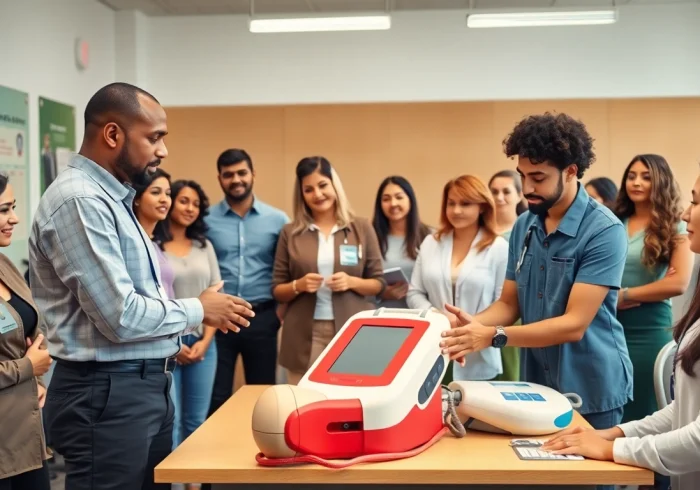Understanding Prescription Applications
What are Prescription Applications?
Prescription applications are digital tools designed to streamline your healthcare experience, specifically focusing on the management of prescriptions. Utilizing mobile and desktop platforms, these applications allow users—patients, physicians, and healthcare providers—to track their medications, schedule reminders for dosages, and manage prescription refills efficiently. Moreover, as healthcare increasingly integrates digital solutions, these applications serve as crucial tools in the broader ecosystem of telehealth and remote patient management. Users can engage with their healthcare providers seamlessly, ensuring that their medication journey is as smooth and effective as possible.
Benefits of Using Top Rated Prescription Applications
Harnessing top rated prescription applications brings numerous advantages:
- Enhanced Accessibility: Patients have 24/7 access to their medication information and can easily communicate with their healthcare providers.
- Improved Medication Adherence: Reminders and notifications help patients remember to take their medications as prescribed, reducing the chances of missed doses.
- Efficient Prescription Management: Patients can request refills directly through the app, avoiding the need for phone calls and streamlining the process.
- Data Tracking and Reporting: Many applications allow users to track their medication intake, helping both patients and providers monitor adherence.
- Cost-Effectiveness: Patients can often find better prices for medications through these applications, helping them save on prescription costs.
Common Features of Effective Applications
When evaluating prescription applications, certain features stand out as essential for providing value:
- User-Friendly Interface: An intuitive design that is easy to navigate ensures that users of all ages can utilize the application without frustration.
- Medication Database: A comprehensive database that includes information on a wide range of medications, including potential side effects, interactions, and dosage instructions.
- Integration with Health Records: The ability to connect with electronic health records (EHRs) promotes a holistic view of the patient’s health.
- Secure Messaging: Asynchronous communication features allow users to send messages to their healthcare providers securely.
- Multi-Device Synchronization: Users can access their information across various devices, ensuring they have their medication details available whenever necessary.
How to Choose the Right Prescription Application
Identifying Your Needs
Every user will have unique needs based on their health status and lifestyle. Start by assessing your specific requirements related to prescription management. For example, do you need reminders for multiple medications? Do you require access to a wealth of information on drug interactions? Identifying these needs helps narrow down your choices and ensures that the selected application aligns perfectly with your health management goals.
Comparing Features and Usability
Once you’ve determined what you need, it’s time to compare features across available applications. Create a checklist of vital functions you require—this may include medication reminders, dosage tracking, refill requests, and educational resources. Additionally, consider the usability of the application; if it is not intuitive or is cumbersome to operate, you might find yourself abandoning it altogether.
Assessing Customer Reviews and Ratings
Customer reviews provide invaluable insight into the real-world usage of prescription applications. Look for reviews specifically discussing functionality, ease of use, and customer support experience. High ratings and positive feedback often signify a reliable application, while consistent complaints can highlight potential issues that could impact your experience.
Impact of Prescription Applications on Patient Care
Streamlining Prescription Processes
Prescription applications significantly enhance the efficiency with which prescriptions are managed. By automating refill requests and providing timely reminders, these tools reduce the administrative burden on both patients and healthcare providers. This streamlining allows providers to focus more on patient care rather than administrative tasks.
Encouraging Patient Engagement
Patient engagement is vital for successful treatment outcomes. Prescription applications encourage patients to take an active role in their healthcare by providing them with easy access to their medication information. Features such as medication history, alongside educational resources, empower patients to discuss their medications effectively with their healthcare providers.
Reducing Medication Errors
Medication errors can have serious health implications, but prescription applications help minimize these risks. By notifying users about possible drug interactions and ensuring that patients stick to their prescribed regimens, these apps are instrumental in enhancing medication safety. Furthermore, features like dose reminders contribute to eliminating missed doses, thus ensuring that patients take their medications as prescribed.
Integrating Prescription Applications in Healthcare
Best Practices for Implementation
When introducing prescription applications into a healthcare setting, adopt best practices to ensure a smooth transition:
- Conduct a Needs Assessment: Before implementation, evaluate the healthcare facility’s specific needs to select an application that meets those needs effectively.
- Involve Stakeholders: Engage healthcare providers, patients, and IT staff in the decision-making process to gather diverse insights and ensure buy-in from all parties.
- Pilot Testing: Implement the application on a smaller scale before full deployment to identify and resolve any unforeseen challenges.
Training Healthcare Staff
Comprehensive training for healthcare staff is critical for successful integration. Staff members should be well versed in the application’s functionalities so they can assist patients effectively. Training sessions should cover everything from technical support to how to educate patients about using the application herself.
Ensuring Patient Privacy and Security
Patients’ privacy must be a top concern when integrating prescription applications. Ensure that the selected application complies with regulations like HIPAA (Health Insurance Portability and Accountability Act) to protect sensitive patient data. Implementing robust cyber security measures, like encryption and user authentication, further safeguards personal healthcare information.
Future Trends in Prescription Applications
Technological Advancements on the Horizon
The future of prescription applications is bright, with several technological advancements on the forefront. Innovations like artificial intelligence (AI) for personalized medicine, machine learning algorithms for predicting patient adherence, and blockchain for securing data transactions are expected to redefine prescription management. These developments will enhance user experiences and improve the overall efficacy of prescription applications.
Expanding Features to Enhance User Experience
As technology evolves, so will the features of prescription applications. Future applications will likely see increased personalization options, such as tailored medication schedules and educational content based on user behavior. Incorporating gamification elements could also enhance user engagement and adherence to prescribed medications.
Regulatory Changes and Industry Standards
The healthcare landscape is sensitive to regulatory changes, and prescription applications are no exception. As regulations surrounding telehealth and digital health continue to evolve, prescription applications will need to adapt while ensuring compliance. Standards ensuring interoperability across various health systems will also become increasingly crucial, enabling seamless integration and data sharing.



